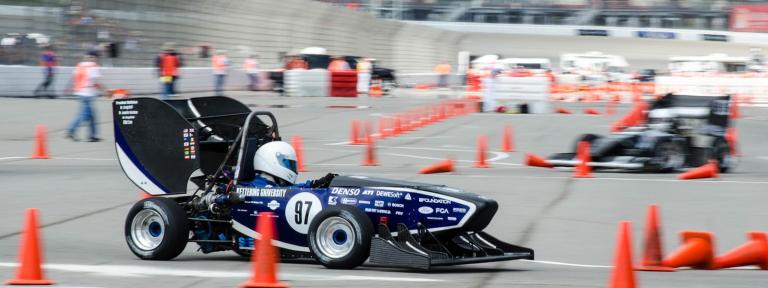
Heeding the adage “when in doubt, leave it out,” Kettering University’s Formula SAE team is “leaving out” the fuel injector and Engine Control Unit (ECU) they were trying to integrate into their car design for this year’s SAE International competition at the Michigan International Speedway May 12 through 15.
Instead, the team will go “old school” with a carburetor. “Most Formula cars have an ECU,” said team leader Joseph Palazzolo, a senior majoring in Mechanical Engineering. “Last year we couldn’t work it out to use an ECU, and wound up using a carburetor, which helped our team with quick start and fuel economy,” he said.
The team wanted to use fuel injection this year because it allows for more customization and better calibrations, and is better for analysis data and to make adjustments, according to Palazzolo. But they were unable to get the fuel injector to fire consistently and kept having “issues, so the decision was made to utilize a carburetor,” Palazzolo said.
During the chaos of the change, they had a chance to get some ideas from Chassis Engineering author Herb Adams ‘61 on possible chassis & suspension improvements to their vehicle. Adams is better known as the “father of the Trans Am,” having been the lead engineer on Trans Am design team. They caught Adams’ attention through an ad in a Kettering alumni publication.
Despite the disappointing attempt at using a fuel injector, the team was able to implement other innovations this year, including the addition of a rear sway bar and adjusting the diameter and length of the exhaust system to significantly increase horsepower and torque.
Another innovation was the shell, or outer covering of the vehicle. “Generally, a race team will use sheets of carbon fiber ply (a weave of carbon fiber) to make the shell, which consists of the nose cone and side pods,” said Palazzolo.
Kettering’s team utilized a chop gun to chop up a spool of carbon fiber, which they sprayed into mold with epoxy and then rolled to create a smooth finish. The process enabled them to save on labor and material costs. The spool of carbon fiber cost between $40 and $50 versus $100-plus for the ply, according to Palazzolo.
“One of the competition factors is overall cost,” he said, “and how to bring costs down throughout the manufacturing process.” Pratt & Miller sponsored the team with help on the body work, both process and material, and by underwriting the paint job and anodizing some of their components, Palazzolo said.
One of the team’s “soft” innovations was to ask for help with the paperwork side of the competition. Included in the Formula competition requirements are a business and marketing plan.
In an effort to keep this year’s marketing budget small while maximizing some of the resources available to them at Kettering, the team asked Marketing professors and on-campus business consultants to review and critique their marketing and business plans prior to competition.
The team’s primary focus, however, was always the vehicle – designing, testing and improving. “Every year a team has to re-design their vehicle, he explained of the changes. Teams can re-use a chassis in another competition within the same year, on the condition they show significant changes in the original design. After 365 days a team has to have a new chassis.
“We have been working on the design of this car since the middle of June 2008, and began manufacture in the fall of 2009,” said Palazzolo. After running the vehicle in California in June 2009, the team stripped down the vehicle, repainted and changed assemblies as part of recycling the original design. The Formula SAE (Michigan), the largest competition in the collegiate design series, is the team’s last chance to drive this design competitively.
“We’ll be competing against about 120 teams, some international, some with small budgets and many with large budgets,” said Palazzolo.
“It’s tough when you’re competing against teams with large sponsorships,” he said, adding “but those working on smaller budgets tend to try and engineer it better to work within their funding level. We’ve come up with some pretty innovative ideas to get a system to work in order to meet the competition deadline or specifications of the event AND our budget.”
If money were no object, Palazzolo said the Kettering team could easily pay registration fees and for transportation to competitions and would have the opportunity spend more on materials and diagnostics equipment.
The end goal for any Formula team is a faster, lighter and more durable car than anyone else has produced, according to Palazzolo.
Calling the experience “priceless,” Palazzolo said that what is most important about the Formula SAE experience is “the amount you learn, and how you are able to apply the skills you learned in class. To see it in action and learn from it, to see what worked and what didn’t and to get excited from that experience and go into next year ready to make it better,” he said.
“Overall, I am proud of this car and this design, Palazzolo said, “and I’m proud of the work the team has done. They put in a lot of effort. Some of the team members recently graduated and are still coming back,” he added.
Fifteen team members are going to the competition at the Michigan International Speedway in Brooklyn, Mich. “It’s kind of like our home competition,” said Palazzolo of the event, “because it is close enough for the team’s corporate sponsors and supporters from Kettering to come see us race.”
Contact: Dawn Hibbard
810.762.9865
dhibbard@kettering.edu